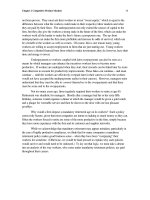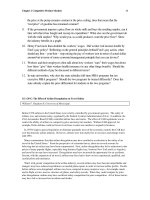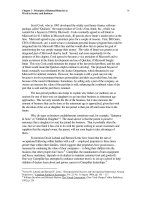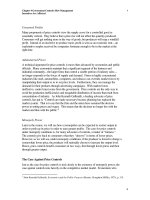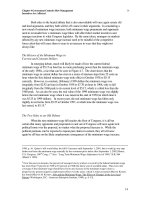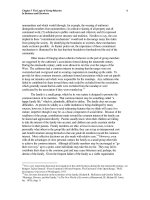Tài liệu Microeconomics for MBAs 17 doc
Bạn đang xem bản rút gọn của tài liệu. Xem và tải ngay bản đầy đủ của tài liệu tại đây (41.84 KB, 10 trang )
Chapter 5 The Logic of Group Behavior
In Business and Elsewhere
29
increases. The workers have to worry about the inclination of each worker group to
garner firm profits at the expense of other groups and the investors. The workers also
have to worry that they have taken over the role of the investors, which is accepting the
risk that comes from being residual claimants. The workers’ insecurities can be
heightened by the fact that the company’s future will be jeopardized by the absence of the
capital that it will need to remain competitive with investor-owned airlines that don’t
have the problems and fears that United might have.
We should not be surprised if, at some later date, the workers effectively try to
“buy back” some security by selling their stake in their company, giving the investors
that right to be tough bosses in exchange for more investment funds and a more certain
income stream for workers (with more of their income coming from wages, salaries, and
fringe benefits and less of it coming from dividends).
Management Snooping
Technology has given workers a chance to loaf on the job while they appear busy at their
desk. All workers have to do is surf the web for entertainment, shopping, and sex sites on
their office computers while giving passersby (including their bosses) the impression that
they, the workers, couldn’t be more focused on company business. And workers are
often good at acting busy and engaged.
At the same time, technology is coming to the rescue of manager/monitors – or
bosses who want to be really tough, if not oppressive. Programs such NetNanny,
SurfWatch, and CyberPatrol enable managers to block worker access to web sites with
certain words on the site, for example, “sex.” However, with the aid of a program called
com.Policy from SilverStone Software, managers now can, from their own desktop
computers, go much further and check out what worker’s have on their computer screens.
The software can take a snapshot of the worker’s computer screen and sends it, via the
local area network, to the boss’ screen. If a worker visits an XXX-rated web site or
writes a love note to a coworker or someone across the country, managers can know it,
and, depending on how tough they want to be, the managers can penalize or dismiss the
workers for using company equipment for personal use. Presumably, the managers can,
with the aid of the software, increase worker productivity, given that the penalties or
threat of penalties, can eliminate worker shirking.
The real question is Should managers use technology that allows them to “snoop”
(to use the characterization of the technology’s critics)? Would workers want them to use
it? Clearly, there are good reasons managers and workers alike would not want to use the
software, it represents an invasion of worker privacy. Many managers and, we suppose,
almost all workers, find “snooping” distasteful. But, as in all other business matters, the
worker problems must be weighed off against the benefits to the firm and workers.
Workers might not want their privacy invaded at the whim of their bosses, but the
workers can understand the now familiar prisoner’s dilemma they are in -- one in which
many of the workers might be inclined to misuse their office computers for private gain
(entertainment, maintenance of love affairs, and sexual stimulation). In large offices, the
Chapter 5 The Logic of Group Behavior
In Business and Elsewhere
30
workers can reason that everyone else is misusing (at least to some extent) their
computers, that their individual misuse will have an inconsequential impact on the firm’s
profitability or survivability, and that they each worker should do what everyone else is
doing, take advantage of the opportunity to misuse their computers – even though long-
run firm profits and worker wages will suffer as a result of what the workers do (or,
rather, don’t do).
Accordingly, workers could welcome the invasion of their privacy, primarily
because the gain in income and long-term job security is of greater value than the loss of
privacy. Managers can use the software simply because they are doing what their
stockholders and workers want them to do, make mutually beneficial trades with their
workers, which is, in this case, ask them to give up some privacy in exchange for the
prospects of higher wages and security.
At the same time, we should not expect that the above deduction will apply in
every worker group. Some worker groups will value their privacy very highly, so highly
in fact that in some instances the managers would have to add more to worker wages than
the firm could gain in greater productivity from use of the monitoring software. In such
cases, use of the software would be nonsensical: it would hurt both the workers and the
firm’s bottom line. Put another way, some bosses aren’t as tough as they might want to
be simply because, beyond some point, toughness – added “snooping” -- doesn’t pay; it
can be a net drain on the company.
Critics of the snooping software are prone to characterize it as “intrusive,” if not
“Orwellian.” One such critic was reported to have reacted to the software’s introduction
with the comment, “It worries me that with the assistance of a variety of tools that every
moment of a person’s workday can be monitored. Workers are not robots that work 24
hours a day without ceasing.”
44
We simply don’t see the matter in such black and white
terms. The old quip “different strokes for different folks” contains much wisdom,
especially in business. We see nothing wrong with employers warning their employees,
“The computers are the firm’s, and we reserve the right to snoop on what you are doing
with the firm’s equipment as we see fit.” To the extent that the (potential) snooping is
seen as a threat to workers, the firm would have to pay in higher wages for the snooping
bosses might do. If they did not pay a higher wage for the announcement, workers could
be expected to go elsewhere, where the firm explicitly rules out snooping. What is
understandably objectionable to employees is the snooping when it is not announced or,
worse yet, when managers profess, or just intimate, that they will not use the available
technology, but then snoop at will. Such managers not only violate the privacy and trust
of their workers, they engage in a form of fraud. They effectively ask their workers to
take a lower rate of pay than they would otherwise demand, and then don’t give their
workers what they pay for, privacy. Moreover, such after-the-fact snooping doesn’t do
what the firm wants, increase beforehand the incentive workers have to apply themselves.
44
As quoted in Lisa Wirthman, “Superior Snooping: New Software Can Catch Workers Goofing Off, But
Some Say Such Surveillance Goes Too Far,” Orange County (Calif.) Register, July 20, 1997, p. 1 and 10
(connect section).
Chapter 5 The Logic of Group Behavior
In Business and Elsewhere
31
Unannounced snooping is just poor management policy on virtually all scores.
With announced snooping policies, workers can sort themselves among firms. Those
workers who value their privacy or on-the-job entertainment highly can work for firms
that don’t snoop. Those workers who value their privacy very little can work for firms
that announce that they might snoop. “Different strokes for different folks” can be a
means of elevating on-the-job satisfaction.
What firms would be most likely to use the monitoring software (or any other
technology that permits close scrutiny of worker behavior)? We can’t give a totally
satisfactory answer. Workplace conditions and worker preferences are bound to vary
across industries. But we can say with conviction that there is no “one-size/fits-all”
monitoring policy. We can only imagine that different firms will announce different
levels of snooping -- with some firms ruling it out, other firms adopting close snooping,
and still others announcing occasional snooping. And many firms with the same level of
snooping can be expected to impose penalties with different levels of severity.
Although we can’t say much in theory about what firms should do, we can note
that the snooping software, and similar technologies, would more likely be used in
“large” firms where the output of individual workers is hard to detect, measure, and
monitor than in “small” firms where output is relatively easy to detect, measure, and
monitor precisely because each worker’s contribution to firm output is such a large share
of the total. The snooping technology would not likely be used among workers whose
incomes are tied strongly to measures of their performance, for example, sales people
who are on commission and far removed from the company headquarters. Such workers
will suffer a personal cost if they spend their work time surfing the web or writing love
notes. Managers should be little more concerned with such workers’ misuse of their
company computers than they are concerned about how their workers use their paychecks
at the mall. If such workers are not performing (because they are “spending” too much of
their pay on net surfing), then the firm should consider the prospect that they need to
increase the cost of wasted time by more strongly tying pay to performance (a subject to
which we return in a later chapter).
By implication, managers will not likely use the software to monitor employees
who are highly creative. “Creativity” does not always happen when workers diligently
apply themselves, and often occurs precisely because workers are relaxed, with the ability
to do as they pleased without fear of being penalized for goofing off. Firms would
probably be more inclined to use the software with employees who are paid by the hour
and have little or no personal payoff from working hard and smart. It should go without
saying that the more workers value their privacy, the less likely monitoring software will
be used. This is because the more workers value their privacy, the more managers would
have to pay in higher wages to invade the privacy.
The Reason for Corporations
Competition determines which business arrangements will survive and which will not.
The prevalence of single proprietorships is explained by the advantage of this business
Chapter 5 The Logic of Group Behavior
In Business and Elsewhere
32
form in producing those products the consumers want as inexpensively as possible. But
changing circumstances can reduce the competitive advantage of a business arrangement
as new arrangements are found to do a better job of organizing productive activity.
Technological advances that took place during the latter part of the nineteenth century
made it possible to realize huge economies from large scale production in many
manufacturing industries. These technological advances shifted the advantage to
business organizations that were far too large to be owned and managed by one
proprietor, or even by a few. But the advantage of large business firms is reduced by the
fact that they make it impossible to concentrate the motivation created by ownership
entirely in the hands of those making management decisions.
Those manufacturing firms that developed organizational arrangements that did
the best job of reducing the disconnection between the owners’ incentives and the
managers’ control were best able to take advantage of economies from large-scale
production. The result was a competition that resulted in the development of the modem
corporation, the business form that today accounts for most of the value produced in the
United States economy, even though small owner-managed firms still make up, by far,
the largest number of firms in the economy.
However, it must be remembered (contrary to what is often taught in business
books) that the corporation (an organization under which investors have limited liability)
was not a creation of the state.
45
The corporation emerged before states got into the
incorporating business. Groups of private investors formed corporations because they
believed that there were economies to be had if they all agreed to create a business in
which outside parties could not hold the individual investors liable for more than their
investment in the corporation (that is, the investors’ personal fortunes would not be at
risk from the operation of the firm, as was and remains true of proprietorships and
partnerships). Clearly, such a public announcement of limited liability (made evident
with “Inc.” on the end of corporate names) might make lenders weary and cause them to
demand higher interest rates on loans. However, the firm would have the offsetting
advantage of being able to attract more funds from more investors, increasing firm
equity, a force that could not only increase the firm’s ability to achieve scale economies
grounded in technology, but would lower risk costs to lenders. Of course, the outside
investors could be hard taskmasters, given that they could shift their investment away
from firms not maximizing profitably. But that doesn’t mean the workers would find the
corporate form unattractive. On the contrary, given the potential scale economies and
risk reductions, corporations may provide more secure employment than small
proprietorships.
Jack Welch, the chief executive officer of General Electric, has played out the
central point of this “Manager’s Corner” because he surely qualifies as a tough boss.
45
Robert Hessen, In Defense of the Corporation (Stanford, Calif.: Hoover Institution Press, 1979) develops
this view of the corporation.
Chapter 5 The Logic of Group Behavior
In Business and Elsewhere
33
Indeed, Fortune once named Welch “America's Toughest Boss.”
46
Welch earned his
reputation by cutting payrolls, closing plants and demanding more from those that
remained open. Needless to say, these decisions were not always popular with workers at
GE. But today, GE is one of America's most profitable companies, creating far more
wealth to the economy and opportunities for its workers than it would have if the tough
and unpopular decisions had not been made. In Welch's words, “Now people come to
work with a different agenda: They want to win against the competition, because they
know that . . . . customers are their only source of job security. They don't like weak
managers, because they know that the weak managers of the 1970s and 1980s cost
millions of people their jobs.”
47
MANAGER’S CORNER II: The Value of Teams
The central reason firms exist is that people are often more productive when they work
together -- in “teams” -- than when they work in isolation from one another but are tied
together by markets. “Teams” are no passing and empty management fad. Firms have
always utilized them. What seems to be new is the emphasis within management circles
on the economies that can be garnered from assigning complex sets of tasks to relatively
small teams of workers, those within departments and, for larger projects, across
departments. However, “teams” also present problems in the form of opportunities for
shirking (which should be self–evident to many MBA students who form their own study
and project groups to complete class assignments). A central problem managers face is
constructing teams so that they minimize the amount of shirking.
At its defense avionics plant, Honeywell reports that its on-time delivery went
from 40 percent in the late 1980s to 99 percent at the start of 1996, when it substituted
teams, in which workers’ contributions are regulated by the members, for assembly-line
production, in which workers’ contributions are regulated extensively by the speed of the
motors that drive the conveyor belts. Dell Computer is convinced that its team-based
production has improved quality in its made-to-order mail-order sales. Within twelve
months of switching to teams in its battery production, a different company,
Electrosource, found its output per worker doubled (with its workforce dropping from
300 to 80 workers).
48
If people could not increase their joint productivity by cooperating, we would
observe individual proprietorships (with no employees other than the owners) being the
most common form of business organization and also the form that contributed most to
national production. As it is, while proprietorships outnumber other business forms (for
example, partnerships and corporations) by a wide margin, they account for only a minor
fraction of the nation’s output. Even then, many proprietorships can’t get along without a
few employees. Single-worker firms tend to be associated with the arts. Few artists have
46
Noel M. Tichy and Stratford Sherman, "Jack Welch's Lessons for Success," Fortune (25 January 1993)
pp. 86-93.
47
Ibid. p. 92.
48
As reported in Paulette Thomas, “Work Week: Teams Rule,” Wall Street Journal, May 28, 1996, p. A1.


